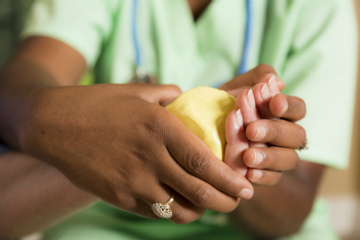Arthritis
What is arthritis?
 The word arthritis means inflammation of the joints, and there are more than 200 different forms of arthritis and related diseases. When inflammation happens it causes pain, redness, heat, swelling, and loss of function. It may be
The word arthritis means inflammation of the joints, and there are more than 200 different forms of arthritis and related diseases. When inflammation happens it causes pain, redness, heat, swelling, and loss of function. It may be
- acute, (severe and sudden), or
- chronic (slow and lasting a long time).
Who can get arthritis?
Arthritis affects people of all ages - even children. It’s true that some types of arthritis, for example osteoarthritis, are more common in older people. However, there are other kinds of arthritis common to both young men and women. There are some forms of arthritis that are more common in women, for example rheumatoid arthritis, while others are more common in men, for example gout.
Types of arthritis
The kind of arthritis which we associate mainly with older people is called osteoarthritis, a degenerative arthritis disease. Others are caused by a malfunction of the immune system for reasons still unclear, and are classified as autoimmune (when the body’s immune system mistakenly attacks healthy tissue) arthritis diseases. Diagnosis of the exact disease among the over 200 different types of arthritis is often difficult and may take some time.
We discuss 7 types of arthritis diseases:
Basal joint arthritis occurs in the base of the thumb that allows swivelling and twisting. It tends to wear out from everyday use, causing pain, stiffness and arthritic symptoms. It can affect both hands and is common amongst women over 40 and men who have worked with their hands for many years. Degenerative basal joint arthritis can develop as a result of normal use and the natural ageing process.
Juvenile idiopathic arthritis (JIA) is the most common type of arthritis in children (under 16) where the immune system mistakenly attacks the body’s tissues, causing inflammation in joints and potentially other areas of the body.
Some of the most common early signs and symptoms of arthritis in children include joints that are warm to the touch, swelling and tenderness at joints, fever, stiffness when waking up in the morning and swollen lymph nodes. However, not all children with JIA will have the same symptoms. Read more about arthritis in children.
Arthritis Kids SA is a support group for children with arthritis and their families. If you would like to know more about this important support group, visit: http://www.arthritis.org.za/Arthritis-Kids-SA/
Giant cell arthritis (GCA) is a type of vasculitis which occurs due to necrosis (death) of one or more arteries. It’s also known as temporal arteritis and cranial arteritis. GCA occurs mostly in the head especially in the temporal arteries that branch from the carotid artery of the neck. However, it can be systemic, affecting multiple medium-to-large sized arteries anywhere in the body. Symptoms include persistent headaches, accompanied by flu-like symptoms or weight loss. Read more about GCA.
Osteoarthritis (OA) is a degenerative form of arthritis that most often affects middle-age to elderly people. Younger people can, however, also get osteoarthritis, primarily from joint injuries. OA is characterised by the breakdown of the cartilage (the tissue that cushions the ends of the bones between joints), bony changes of the joints, deterioration of tendons and ligaments, and various degrees of inflammation of the joint lining (called the synovium). Read more about OA.
Psoriatic Arthritis (PsA) is an autoimmune disease that affects the joints and skin. The faulty immune response causes inflammation that triggers joint pain, stiffness and swelling. The inflammation can affect the entire body and may lead to permanent joint and tissue damage if it isn’t treated early. Read more about PsA.
Reactive arthritis is an inflammatory type of arthritis which affects the joints, and may affect the eyes, skin and urinary tract and occurs when bacteria enter the blood stream from 1 or both of the following areas of the body:
- Urogenital tract. Bacteria can enter through the vagina or urethra during sexual contact and spread to the bladder.
- Gastrointestinal (GI) tract. Bacteria can enter the body if you eat spoiled food or food that came into contact with contaminated surfaces.
Unlike rheumatoid arthritis or osteoarthritis, reactive arthritis is usually a short-lived condition that lasts for less than 6 months and, in most cases, disappears completely leaving no problems in the future. Read more about reactive arthritis.
Rheumatoid arthritis is a form of inflammatory arthritis affecting your general health as well as a variety of joints. Rheumatoid arthritis is the most common of the auto-immune arthritis diseases, found in about 1 in 100 people worldwide. If left untreated it could affect any functional part of the body. Read more about rheumatoid arthritis.
Treatment options
Different types of arthritis are treated with different medicine. Some drugs control symptoms. For example, analgesics reduce pain and anti-inflammatory drugs reduce swelling and stiffness. Other medicines affect the disease itself. A combination of medicines and treatments may be used to treat arthritis.
Medicine used to treat arthritis can be divided into 4 broad groups:
- Painkillers: These relieve pain. They’re used for many different types of arthritis and are often used together with other medicine.
- Non-steroidal anti-inflammatory drugs (NSAIDs): These reduce inflammation of the joint as well as pain. They’re used for many different types of arthritis.
- Disease-modifying anti-rheumatic drugs (DMARDs): These medicines are used mainly in the treatment of rheumatoid arthritis, and reduce pain, swelling and stiffness.
- Corticosteroids: These medicines are very effective in controlling inflammation and may have some disease-modifying effects.
Consult your nearest clinic or hospital for advice on the best treatment option for you.
Exercise and eat healthy
Although there's no diet cure for arthritis, certain foods have been shown to fight inflammation, strengthen bones and boost the immune system.
 The most important link between your diet and arthritis is your weight. Being overweight puts an extra burden on the joints, especially weight-bearing joints, including your back, knees, hips, feet and ankles. Having too much body fat may also increase inflammation in the body, making your joints more painful.
The most important link between your diet and arthritis is your weight. Being overweight puts an extra burden on the joints, especially weight-bearing joints, including your back, knees, hips, feet and ankles. Having too much body fat may also increase inflammation in the body, making your joints more painful.
A good diet can also help to protect you against some potential side effects of arthritis medication, and a healthy diet may also help to protect against heart disease. Adding these food groups to your balanced diet may help ease the symptoms of your arthritis.
Exercise is also important because it can help you to:
- ease stiffness,
- improve your fitness,
- improve joint movement,
- strengthen muscles,
- keep your heart healthy,
- lose weight, putting less strain on your joints, and
- strengthen bones and maintain bone density.
Aside from these benefits, exercise also has positive mental effects. You'll feel much better and more self-confident when you've done some exercise. This can affect the way you cope with your arthritis symptoms.
More information
- You can contact the Western Cape branch of the Arthritis Foundation of South Africa at (021) 425 4759 or (021) 425 475.
- You can also read more about arthritis on www.arthritis.org


